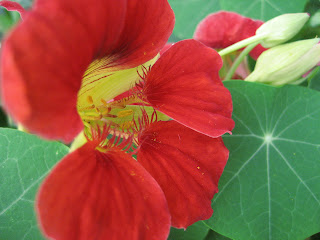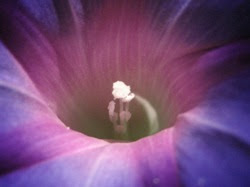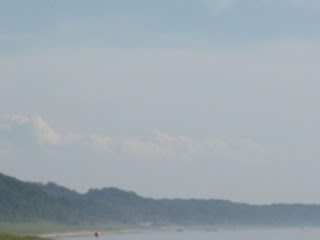Clement A. Miles, Christmas in Ritual and Tradition, Christian and Pagan, 1912

Read over your compositions, and when you meet anything you think particularly fine, strike it out. Samuel Johnson


"Aunt Edna and Eula Mae."
When a farm girl gets dressed up to have her picture taken ... or was she a city girl, and this her high school graduation photograph? If so, she would have been unusual. My grandmother, a city girl probably of about the same generation, always bragged about having graduated high school, which girls didn't necessarily do in the early part of the 20th century.
I like the little pearls around her neck. They represent glamor and wealth, can't possibly be real -- and aren't remotely needed. She is far lovelier than they are.
The Little Red Schoolhouse is a landmark of Chicago's (more properly, Cook County's) south suburban forest preserves. Many a childhood has taken the obligatory detour through here, many times over, on many and many a summer -- spring, winter, fall -- day.This happened to be a day in early September.
The land is low lying, marshy and forested all at once. Yet by the time you drive out as far as this, along very gently dipping and rolling narrow two-lane roads, you have also run between startlingly tall and thickly wooded bluffs, reminiscent of scenery around the southern end of Lake Michigan. (A geologist might argue this is the southern end of Lake Michigan.) All of this is fifteen minutes from busy "blight strip" intersections and huge shopping malls where you may, oh, stop in and buy a beer.
Above is the old little red schoolhouse, which is not quite absolutely original. The very most absolutely original schoolhouse stood strangely high up in the woods, on a cramped and isolated site which someone, we trust, took the trouble to note down accurately. As per the sign, below:
Why were nineteenth century children compelled to leg it up here to their lessons? To what roads or farms did this clearing seem convenient?
That school building vanished. Our own little red schoolhouse stood elsewhere for a long time. When it was no more needed as a school (in the fifties), it was moved to its current spot, and here for years it served as many childhoods' nature center. You know the type. Inside were the obligatory glass tanks of fish and snakes, the obligatory taxidermied foxes and skunks and hawks, the little look-'n'-see, lift-the-panel dioramas on how birds molt, tornadoes form, or leaves decompose. The displays allowed you to get close to the animals and birds whose living counterparts are always past masters at hiding in the woods. A noble deer head presided over all, and still does.
Amid the nature things, the schoolhouse always included monuments to itself. Here is a replica under glass of the absolutely original school, a display which is somehow disconcerting -- one expects to hear Rod Serling introduce an episode of The Twilight Zone.
And below, also under glass, is some child's actual old slate; next to it, an empty spot where a McGuffey reader should be.
Upon stepping outside, there was never much to see except acres of trees. And signs. From environmentalism's 1970s heyday up to only a few years ago, the Little Red Schoolhouse was known -- or at least, I thought it should have been known -- for its angry, scolding signs warning visitors about human depradations on our suffocating and helpless planet. One sign was carved with a treacly poem in which Mother Earth pleads "Save Me One Swamp." Lilacs and such nice plants were banished behind fences and then further stigmatized with horrible epithets, "non-native," "invasive," "introduced by European settlers." For years a fake graveyard lurked just outside the back door; its tombstones marked the supposed deaths of "clean water" or "clean air." Now, with the whole property's refurbishment, the graveyard and most of the scolding signs are gone. The one pictured below gives an idea of that old fighting spirit.
Refurbishment has come just this past summer, thanks to the Forest Preserve District of Cook County -- which is to say, thanks to our tax dollars.This is the new Little Red Schoolhouse Nature Center.
It's splendid, I suppose -- two million dollars, or something, I think I heard -- but in broad outline it looks like any other nature center, or first floor college admissions headquarters, or foyer of a really environmentally conscious bank. And now it has a concept. You don't simply wander about. The concept is that after you walk in and see a few of your old friends in glass tanks, plus peek into a reconstructed Indian tepee, you are guided down a long switchback ramp that leads you imaginatively (and rather confusingly) forward through time, from the earliest ages of lava and fossils to bugs and fish and mastodons and finally people. The fossils built into the walls are real, and locally dug.
Above, an orthocone cephalopod, from the late Ordovician-to-Triassic (200 million years ago), situated near the top of the switchback path. The descent forward through time makes it convenient to place a big and not-anachronistic pool at sub-basement level, for modern day turtles to swim in.
The old fighting environmentalist spirit is alive and well here, too. Note the staff member, in eco-friendly green, pointing at and scolding the man beside the pond, for having just done something wrong. He touched the water, I think, and was told that if everyone does that, they will have to build a protection over the pool and no one will be able to enjoy it. He had his children with him.
I appreciate the effort that has gone into this updating, but I only wonder who decides that a nature center shall be set up this way -- as a journey through geologic time. The idea is useful enough, especially if you want to reassure human beings what a temporary blot on the landscape they are compared to cockroaches or dinosaurs, but I wonder how many nature centers follow this pattern. I wonder whether or not, at the two-million-dollar committee meetings where this was decided, any different ideas were put forth. How would you design a nature center? Regardless, we can be sure that the brains behind this work all went to college and all absorbed the correct things there. Note the sign explaining "First Contacts" between Europeans and Indians.
All in all it's a relief to get out to the old paths, the woods, the meadows, and the water. Some things are eternal.
A red winged blackbird dines on berries. The flower below is, I think, chicory. I remember reading somewhere that some portion of the plant used to serve pioneers to make "coffee."
Eventually, the main hiking trail returns you to the schoolhouses, old and new. Facing this pond, the beehives and the apple orchard (invasive?) are at your back. The powers that be have uprooted the old farmer's garden, and got rid of its extremely homemade and vintage scarecrow.
In the parking lot, if you hadn't seen it already, you will notice one last scold.
The rest of the lot was crammed with cars, but nobody was parked there.Which indicates a) we're deeply obedient to scolding signs and b) nobody wants to buy or drive environmentally friendly cars, because they are inefficient.
Save me one swamp? I think not. There's no end of swamps. Save me one old fashioned suburban nature center, rather.




















































